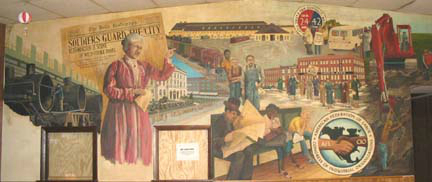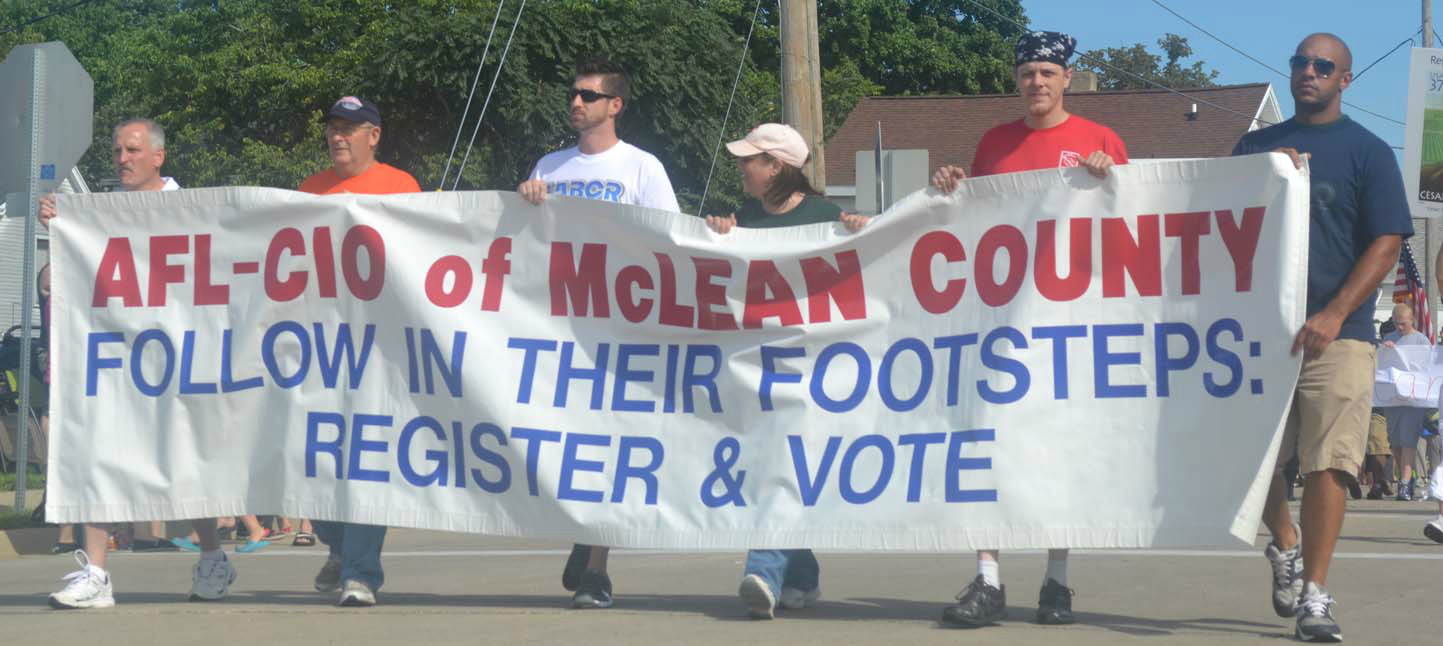|
Bloomington had its wildest labor night a century ago, July 5, 1917, with famed labor organizer Mary “Mother Jones” (1837-1930) stoking striking transit workers. A night of mayhem brought 1,400 National Guard troops to town, but also won a contract for Amalgamated Transit Union Local 752. Local 752 will celebrate its centennial in July.
Before the automotive age, people walked to work or rode electric trolleys or streetcars. The Bloomington & Normal Street Railway (B&N), which began as a horse-drawn railway in 1867, carried passengers on 23 route miles through Bloomington & Normal. Transit workers had formed a union in 1902, lost it after a six-month strike in 1904, and came back in 1917 to organize again.
In 1917, the B&N was owned by U.S. Congressman William McKinley (1856-1926). McKinley controlled the streetcar systems in Champaign, Peoria, Galesburg and Danville, along with the Illinois Traction System, an electric interurban railroad that connected St. Louis with Peoria, Danville, Springfield, Champaign, Decatur and Bloomington. Thanks to its electric generating capacity, this eventually became the Illinois Power Company, today’s Ameren.
Although the streetcar system meant a modern city a century ago, it was tough on workers. David Law (1852-1916) began work on the horse cars, standing on an open platform, exposed to the weather, for a fifteen-and-a-half-hour day. He said, “I have stood on this platform with the thermometer twenty-four to thirty degrees below zero, and I have made my way through mountainous snow drifts, and when the rails were a glare of ice, as well as through beating rains and burning suns. No, we haven’t a soft job and we literally earn our bread by the sweat of our brow.” The transit workers labored seven days a week for $50 per month. To get a day off, they pooled their funds so they could buy a replacement for one day off per month. Law noted that on that one day off, his children asked, “who is that strange man in the house?”
By 1917, the trolley workers made $2.25 a day, for a nine-and-a-half-hour workday. On May 17, 1917, 50 workers met at midnight, with the assistance of Jerry Burnette from Peoria Local 416 of the Amalgamated Association of Street & Electric Railway Men (today’s ATU - Amalgamated Transit Union). At first the company refused a pay increase, but eventually offered 20 cents per day. The workers wanted more – union recognition. The company refused. On May 28, the strike began. Half the workers, satisfied with the pay raise, stayed with the company. The strikers made clear their goal – union recognition.
“The strike of the Bloomington street car employees has been called for the reason that the company denies us the right which millions of workingmen all over the United States are exercising, and have been exercising for years – the right to organize.
“We believe our cause is just and we ask for the support of the public in asserting our rights as citizens of a free country.”
The strikers, and the Bloomington Trades & Labor Assembly, both asked Mayor E.E. Jones to mediate. The company refused the mayor’s offer. The workers asked the public to boycott the cars and support the strike.
On June 9, at the company’s request, Judge Sain Welty issued a sweeping court injunction, which basically forbade almost all strike activities and public outreach. The court injunction forbade the union and its members from congregating on street corners, distributing hand bills, sending out any communication or asking people to boycott.
On June 11, a strike rally was held, with speeches by Illinois Federation of President John Walker, a coal miner, and Bloomington & Normal Trades & Labor Assembly President John Lennon. The strikers were encouraged to refrain from violence and to win the public’s approval. That night, the streetcar company’s powerhouse workers walked out in a sympathy strike.
After a month on strike, with the streetcars running and a repressive court injunction limiting strike activity, the situation was becoming desperate. To rally their cause, they turned to a famous worker advocate, Mary “Mother” Jones.
Jones was an Irish immigrant, a child refugee from the potato famine. She lost her husband and children to a yellow fever epidemic in 1867. She came to Chicago, working as a dressmaker for wealthy families. As she neared her sixties, she became a living symbol of labor outrage. Labeled “the most dangerous woman in America,” by the early 1900s she was tramping across the United States, organizing coal miners, fighting against child labor, and finding herself thrown in and out of jail cells.
On July 5, 1917, she addressed a packed audience at the Eagle’s Hall. What survived from her speech was her final admonition, to “go out get ‘em.” Leaving the Eagle’s Hall, the excited crowd attacked an approaching streetcar, beating the strikebreakers. They then marched on the Courthouse Square, where a strike breaker, Thomas Huett, fired a pistol into the crowd, grazing railroad worker Emmett Maloney. Huett was spirited away by police. A streetcar approaching from Miller Park was attacked and the strikebreakers taken away, for their own safety, by the police.
Hoping to shut down the system’s electric power, the crowd surged down Main and Madison Streets to the B&N’s electric powerhouse. The Mayor, police chief and police were guarding the doors. Stones and bricks were thrown through windows. The Pantagraph reported, “Several women reported to be wives of the street car men sought to incite the men to action. With waving of arms and handkerchiefs and their shrill voices, they created much sympathy.” The streetcar workers’ President, John Nitzel, told the mayor the crowd would stop if the power was shut off. After Nitzel and the Mayor inspected the plant, it was shut down. The crowd returned to the courthouse square, confronted by police, with warning shots fired. Finally, Mayor Jones agreed to try and mediate again.
The next morning, July 6, the Mayor convened a mediation. Looking at the striking workers, Daniel W. Snyder, the B&N’s superintendent, said, “I cannot recognize the car men’s union.” He then walked out the door. As this took place, Illinois National Guard troops arrived, encamping at the B&N’s power plant and the Courthouse, where they pitched camp and set up machine gun emplacements.
Bloomington’s largest employer in 1917 was the Chicago & Alton Railroad, with its extensive repair shops on the west side. During lunch, almost 1,200 Shops’ workers laid down their tools, marching on city hall. The Mayor reached out to B&N Superintendent Snyder’s boss, the Illinois Traction System’s H.E. Chubback, and also the company’s owner, Congressman McKinley. The two agreed to talk. Congressman McKinley telegraphed back, “I recognize the right of men to organize.”
On Monday, July 9, the mediation conference began. After four-and-a-half hours of negotiation, the union was recognized, the strikers reinstated to their jobs. The workers won a 35-cents a day increase and their work day was decreased from 9 and-a-half hours to nine.
Thus, Amalgamated Association of Street and Electric Railway Men Local 752, today’s Amalgamated Transit Union Local 752, won their first contract, after a bitter strike, facing court injunctions and company refusal. Thanks to a fiery 80-year-old woman and union solidarity, a small band of transit workers built a union, which survives and thrives a century later.
by Mike Matejka
Download:
|



